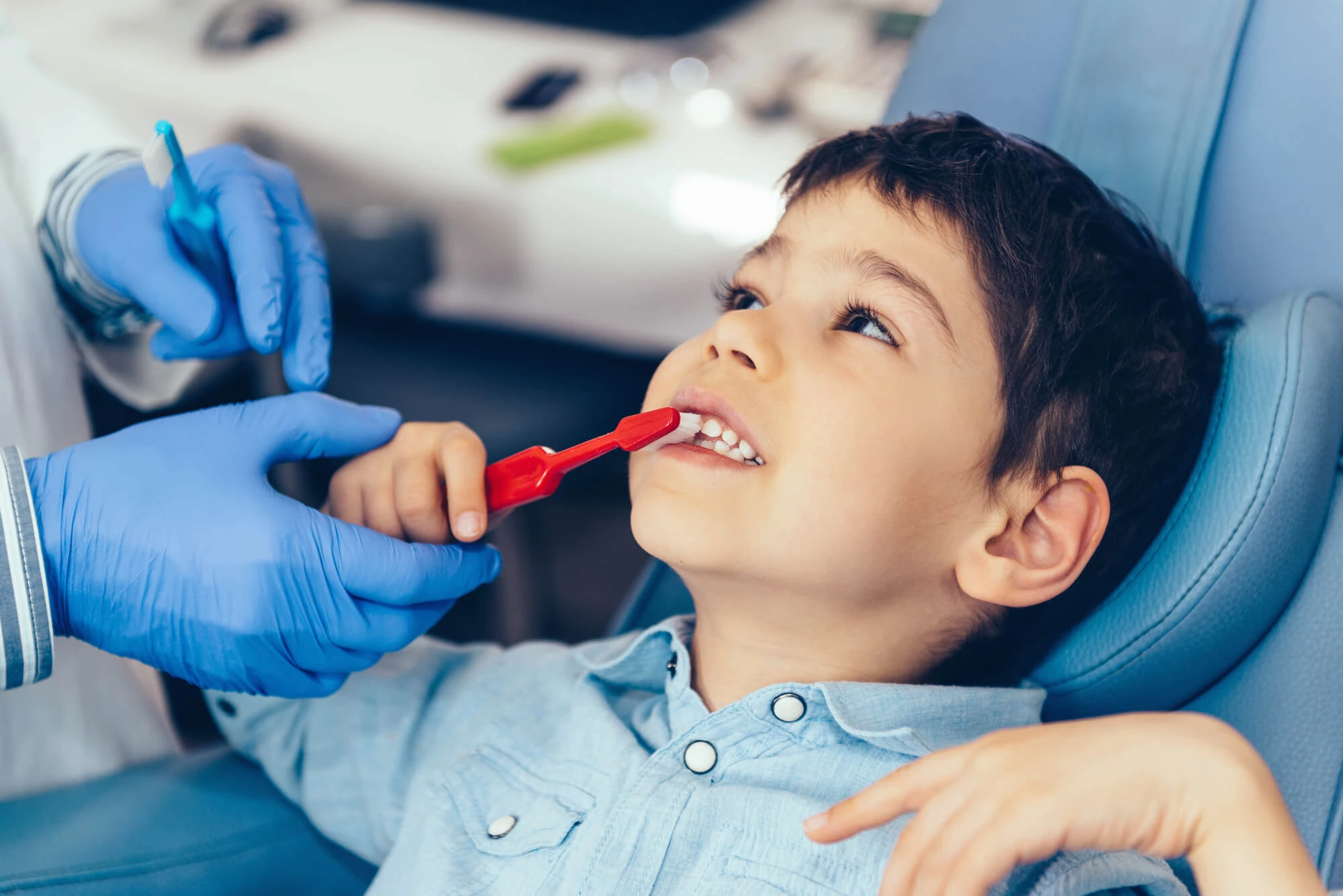While gum disease is associated with adults, your Coral Gables family dentist may recommend better hygiene to prevent it from developing in your child’s smile. Caused by bacterial growth, gum disease is a dangerous condition that starts subtly but can put your oral health at risk in the long run.
By understanding how gum disease happens, how to identify it, and what you can do to prevent it, you can help keep your child's mouth in top condition.

Gum disease, also known as periodontal disease, is a common but serious oral health condition that affects the gums and supporting structures of the teeth. It begins with bacterial growth, particularly along the gum line, and, if left untreated, can lead to gum inflammation and bleeding gums.
If gingivitis is left untreated, it can progress to periodontitis, where plaque spreads below the gumline, and toxins cause the gums to pull away from the teeth. This forms pockets that collect more bacteria and lead to bone and tissue destruction.
Children can develop gum disease, especially when they don’t follow a regular oral hygiene routine at home. In fact, this disease is very common: According to a study by the American Academy of Pediatric Dentistry, gingivitis affects almost 50% of kids.
The good thing is that children who get gingival infections tend to develop gingivitis only at its beginning stages. The disease typically doesn't progress to more serious degrees, when tooth loss and jawbone damage become possible.
But why do children develop gum disease?
Let’s face it—children aren’t very good at keeping up with good oral hygiene habits. No one loved brushing their teeth as a child, and if your child is sleepy at night, they can easily decide it’s a step they can skip.
Sadly, this forgetfulness lets bacteria accumulate along the gum line and cause inflammation. Moreover, many children skip flossing, which is crucial for removing plaque between the teeth—where gum disease often starts. Poor technique or rushing through brushing also reduces its effectiveness.
While helpful for aligning teeth, braces and other orthodontic appliances can make oral hygiene more challenging. Brackets and wires create extra surfaces where food and plaque can collect, increasing the risk of gum inflammation.
Kids with braces need to be especially careful with brushing and flossing, but many struggle to clean effectively around their appliances, leading to localized gingivitis around the brackets.
Children love sweets. However, high-sugar and high-carb snacks—such as sodas, chips, and candy—feed the bacteria in the mouth, which produce acids that are harmful to teeth and gums.
Frequent snacking also means the mouth is constantly attacked, especially if oral hygiene isn’t performed after eating. Over time, this can contribute to gum inflammation and tissue damage.
Teenagers are particularly vulnerable to gum disease. One of the biggest reasons is the hormonal changes that occur during puberty. As hormone levels rise—especially estrogen and progesterone—blood flow to the gums increases, making the gum tissue more sensitive and reactive to plaque and bacteria.
This means that even a small amount of plaque buildup can lead to inflammation, tenderness, and bleeding. This condition is sometimes referred to as “puberty gingivitis,” and it can develop quickly if good oral hygiene isn’t maintained.
Smoking is another cause of gingivitis in teenagers. Unfortunately, some teens begin smoking or vaping in high school. Both tobacco and e-cigarettes increase the risk of gum disease by reducing blood flow to the gums, weakening the immune system, and masking early symptoms like bleeding.
Lastly, stress affects the immune system and makes it harder for the body to fight off infections, including gum infections. Teens under stress may also neglect oral hygiene, further compounding the problem.

Various factors can raise your child’s risk for periodontal disease. Some of these include:
Symptoms of gum disease depend highly on the stage of the disease. Most children only develop their mildest form, so pay attention to issues like:
Most of these symptoms may seem like other health problems, which is why regular dental visits play a big role in early gingivitis identification. The American Dental Association recommends that you take your child to a dentist every six months to identify this and any other issue—like cavities—while it’s still mild and easily treatable!
Your child’s dentist can often diagnose periodontal disease with a complete history and exam of their teeth and gums. Your child may also need X-rays. If the disease is advanced, we may refer you to a periodontist—but this is only reserved for severe cases.
Periodontists are dentists who specialize in treating issues with periodontal tissue, that is, the gums.
Treatment will depend on your child’s symptoms, age, and general health. It will also depend on how severe the condition is. Some options include:
Establishing a strong oral hygiene routine is the first and most important step in treating gum disease. Many children and teens develop gingivitis simply due to poor brushing and flossing habits. Dentists will typically begin treatment by teaching proper techniques:
Parents may need to assist or supervise brushing for younger children until good habits are formed. Teens with braces may need special tools like floss threaders or water flossers to clean around brackets and wires effectively.
If gingivitis is present, a professional dental cleaning is usually the first clinical treatment step. A hygienist or dentist will:
This cleaning helps reduce inflammation and allows the gums to begin healing. In most mild to moderate cases, this alone, combined with better home care, can resolve the issue.
In more advanced or persistent cases—particularly in teens—a procedure called scaling and root planing may be recommended. This is a deeper cleaning that targets plaque and tartar below the gumline and on the tooth roots.
It helps:
This treatment may be done under local anesthesia and often requires multiple visits depending on the extent of the gum disease.
In some cases, dentists may prescribe topical or oral antibiotics, especially when inflammation is severe or there’s a risk of infection. These can be:
These are typically used alongside mechanical cleaning to help control bacteria and promote healing.
Gum health can be more difficult to manage for children and teens undergoing orthodontic treatment. Dentists may recommend specific brushing tools and schedule more frequent cleanings. In some cases, adjustments to orthodontic appliances may be needed.
If lifestyle factors like smoking or vaping are involved, quitting is critical. Education and support from parents, dentists, and school counselors can make a big difference in preventing disease progression.
Ongoing monitoring is essential to ensure the gum disease is under control. Children and teens with gum issues may need more frequent cleanings (every 3–4 months) to prevent recurrence.
The good news is that gum disease is highly preventable and reversible in its early stages. Parents and teens should work together to ensure consistent brushing and flossing, regular dental checkups, and healthy dietary habits. Orthodontic patients may benefit from specialized tools like water flossers or interdental brushes.
By catching and addressing gum issues early, we can protect their smiles now and into adulthood.

Early treatment is important when it comes to gum disease. Diagnosing and addressing this disease early on can prevent it from getting worse and prevent irreversible damage to your child’s gums and underlying bone.
While gum disease in its severe stages is less common in children, don’t let yourself be. Visit a family dentist at Coral Gables Dentistry regularly, and let us help you ensure your child’s smile stays in top condition!

We value your time, so we always run on schedule, respecting your commitments, with no double bookings and minimal wait times. Experience dentistry like never before in our award-winning clinic.






